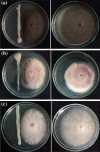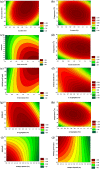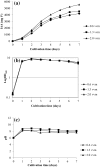High-yield production of indole-3-acetic acid by Enterobacter sp. DMKU-RP206, a rice phyllosphere bacterium that possesses plant growth-promoting traits
- PMID: 28948133
- PMCID: PMC5592160
- DOI: 10.1007/s13205-017-0937-9
High-yield production of indole-3-acetic acid by Enterobacter sp. DMKU-RP206, a rice phyllosphere bacterium that possesses plant growth-promoting traits
Abstract
Enterobacter sp. DMKU-RP206 was isolated from rice leaves in Thailand and identified by the 16S rRNA gene and multilocus sequence (gyrB, rpoB, atpD, and infB genes) analysis. The bacterium was assessed on plant growth-promoting traits including indole-3-acetic acid (IAA) production. Phosphate solubilization, ammonia production, and antagonism to fungal plant pathogens, as well as siderophore production, were shown by this bacterium. However, only IAA production was focused on. The production of IAA by Enterobacter sp. DMKU-RP206 was optimized by statistical methods. A Box-Behnken design was used for the investigation of interactions among the basic influencing factors and for the optimization of IAA production. The results showed that l-tryptophan had a significant importance in terms of IAA production. Enterobacter sp. DMKU-RP206 produced a higher amount of IAA than previously reported for the genus Enterobacter. 0.85% of lactose as a carbon source, 1.3% of yeast extract as a nitrogen source, 1.1% of l-tryptophan as a precursor, 0.4% of NaCl, an initial pH of 5.8, an incubation temperature at 30 °C, and a shaking speed of 200 rpm were found to be the optimum conditions for IAA production. In addition, IAA production was performed to scale up IAA production, and the highest amount, 5561.7 mg l-1, was obtained. This study reported a 13.4-fold improvement in IAA production by Enterobacter sp. DMKU-RP206.
Keywords: Enterobacter sp.; Indole-3-acetic acid; Multilocus sequence analysis; Optimization; Phyllosphere bacteria; Plant growth-promoting traits.
Conflict of interest statement
The authors declare that they have no conflict of interest in the publication.
Figures






Similar articles
-
Production of Indole-3-Acetic Acid by Enterobacter sp. DMKU-RP206 Using Sweet Whey as a Low-Cost Feed Stock.J Microbiol Biotechnol. 2018 Sep 28;28(9):1511-1516. doi: 10.4014/jmb.1804.04043. J Microbiol Biotechnol. 2018. PMID: 30369114
-
Plant growth-promoting traits of epiphytic and endophytic yeasts isolated from rice and sugar cane leaves in Thailand.Fungal Biol. 2014 Aug;118(8):683-94. doi: 10.1016/j.funbio.2014.04.010. Epub 2014 May 10. Fungal Biol. 2014. PMID: 25110131
-
Screening and optimization of indole-3-acetic acid production and phosphate solubilization by rhizobacterial strains isolated from Acacia cyanophylla root nodules and their effects on its plant growth.J Genet Eng Biotechnol. 2020 Nov 11;18(1):71. doi: 10.1186/s43141-020-00090-2. J Genet Eng Biotechnol. 2020. PMID: 33175273 Free PMC article.
-
Indole-3-acetic acid production by newly isolated red yeast Rhodosporidium paludigenum.J Gen Appl Microbiol. 2015;61(1):1-9. doi: 10.2323/jgam.61.1. J Gen Appl Microbiol. 2015. PMID: 25833674
-
Bacterial catabolism of indole-3-acetic acid.Appl Microbiol Biotechnol. 2020 Nov;104(22):9535-9550. doi: 10.1007/s00253-020-10938-9. Epub 2020 Oct 10. Appl Microbiol Biotechnol. 2020. PMID: 33037916 Review.
Cited by
-
Humic Substances in Combination With Plant Growth-Promoting Bacteria as an Alternative for Sustainable Agriculture.Front Microbiol. 2021 Oct 29;12:719653. doi: 10.3389/fmicb.2021.719653. eCollection 2021. Front Microbiol. 2021. PMID: 34777275 Free PMC article. Review.
-
Differences in Distribution of Potassium-Solubilizing Bacteria in Forest and Plantation Soils in Myanmar.Int J Environ Res Public Health. 2019 Feb 27;16(5):700. doi: 10.3390/ijerph16050700. Int J Environ Res Public Health. 2019. PMID: 30818756 Free PMC article.
-
Large scale production of indole-3-acetic acid and evaluation of the inhibitory effect of indole-3-acetic acid on weed growth.Sci Rep. 2021 Jun 22;11(1):13094. doi: 10.1038/s41598-021-92305-w. Sci Rep. 2021. PMID: 34158557 Free PMC article.
-
Identification and Optimisation of Indole-3-Acetic Acid Production of Endophytic Bacteria and Their Effects on Plant Growth.Trop Life Sci Res. 2023 Mar;34(1):219-239. doi: 10.21315/tlsr2023.34.1.12. Epub 2023 Mar 31. Trop Life Sci Res. 2023. PMID: 37065794 Free PMC article.
-
Streptomyces sp. strain TOR3209: a rhizosphere bacterium promoting growth of tomato by affecting the rhizosphere microbial community.Sci Rep. 2020 Nov 18;10(1):20132. doi: 10.1038/s41598-020-76887-5. Sci Rep. 2020. PMID: 33208762 Free PMC article.
References
-
- Ahemad M, Khan MS. Plant growth promoting activities of phosphatesolubilizing Enterobacter asburiae as influenced by fungicides. EurAsia J BioSci. 2010;4:88–95. doi: 10.5053/ejobios.2010.4.0.11. - DOI
-
- Arraktham S, Tancho A, Niamsup P, Rattanawaree P. The potential of bacteria isolated from earthworm intestines, vermicompost and liquid vermicompost to produce indole-3-acetic acid (IAA) J Agric Technol. 2016;12:229–239.
-
- Bakker AW, Schipper B. Microbial cyanide production in the rhizosphere in relation to potato yield reduction and Pseudomonas spp. mediated plant growth stimulation. Soil Biol Biochem. 1987;19:451–457. doi: 10.1016/0038-0717(87)90037-X. - DOI
LinkOut - more resources
Full Text Sources
Other Literature Sources

